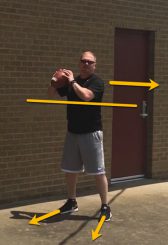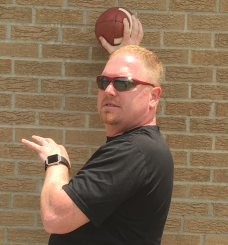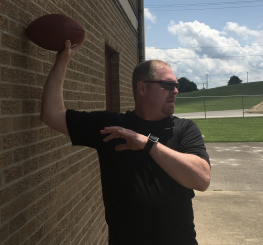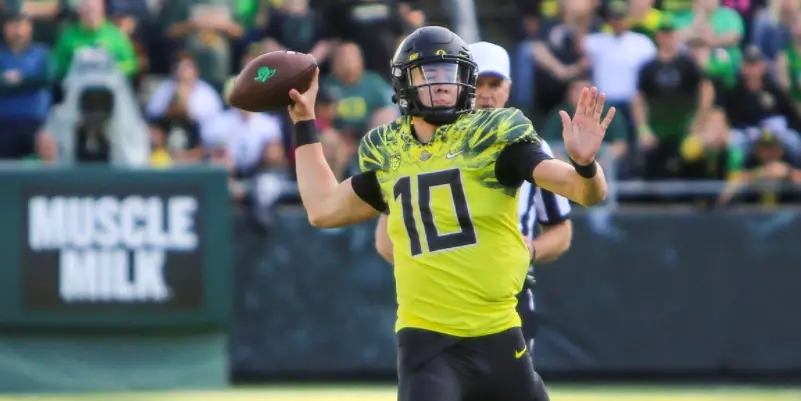Football is the ultimate team sport. Even so, the quarterback position has a far greater impact on a team’s fortunes than any other single position. A quarterback injury can ruin an entire football season, as Ducks fans witnessed in 1987, 1991, 1993, 2007 and 2015.
The reason is the extreme talent needed to play the position. Let’s see some instruction that can help refine some quarterbacking skills and learn more football!
In the series Quarterback Head to Toe, I will share insights I have acquired in 35 years of playing and coaching football. We’ll start with how to teach the throwing motion: what is the correct form and process for fans to look for?

Fran Curci with Quarterback Standout Mike Deaton
I first started working on my throwing motion in eighth grade with my coach Mike Deaton, a former University of Kentucky QB standout. I noticed right away that he could really throw the ball, with a tight spiral and great distance.
But what really got my attention was a “snap” in his release that made the ball seem to shoot out of his hand. This was something I wanted to learn as well.
I worked on emulating Coach Deaton’s throwing motion all season. Developing the perfect form got to be something of an obsession for me, and eventually I got it down to the point that it was pretty automatic. This helped give me the confidence that I needed to be able to face adversity on Friday nights.
Coach Deaton taught me quarterbacking skills that I have been able to apply throughout my playing and coaching career. The hardest of those skills to master is throwing the football — I spend a lot of time on it with my QBs. When a QB can throw the football well, it gives him the confidence he needs to learn all of the other things that he needs to know to get good at the position.
Start with the Mind
In my years of experience, I’ve coached many different types of QBs. Some were drop-back passers, some were runners and others were a hybrid of both. Regardless of the style of play, working on the mental side of the QB position has to come first.
When I begin working with a freshman quarterback, my first priority is to establish a rapport and trust. The next step is to instill a sense of pride about the craft of playing QB. That pride motivates a player to perfect his skills, which leads to confidence. With that confidence comes the ease of a leader who is fearless during adversity.
 Ball and Foot Placement
Ball and Foot Placement
Good throwing mechanics start with proper ball and foot placement. As you can see in the picture to the right, the back foot is placed on a line perpendicular to the hips. The front foot is set at about 45 degrees to the back foot, slightly wider than shoulder width.
This positions the feet in line with the step that the QB will take when throwing the football. It also aligns the hips with the target. This positioning allows the football to be thrown with greater accuracy.
The ball is placed in a comfortable position slightly in front of the back shoulder, secured with both hands. I teach QBs to keep the ball above the chest and parallel to the shoulders when throwing.
Hitting the Wall
Hitting the Wall is a drill I use to help position the ball correctly during the throwing motion. The QB stands in front of a wall, with his feet positioned to throw at a target directly away from it. When he cocks his arm to throw, the nose of the ball should just tap the wall.


This promotes a quality release, giving the QB the greatest opportunity to throw the football at a high velocity. It promotes a high release as well, which makes the ball easier for receivers to spot in the air, and also helps to keep it from being batted down by oncoming defenders.
Above is a video of the drill.
The Snap
The snap is an essential part of developing velocity when releasing the ball. It is paramount that quarterbacks develop this technique to maximize their throwing ability. A player does not have to have a 250-pound bench press to have strong velocity on the football if the snap is developed.
Look at the video above to see a quality throwing motion, from hitting the wall to the follow-through.
The snap begins when the QB separates his hands at the beginning of the throw, pressing the ball behind the head quickly. Notice how the throwing hand works across the body and the thumb is pointing towards the ground upon the release of the football. This creates greater rotation speed, which enhances the spiral of the football.
You will also notice that the rotation of the hips is important for velocity as well. The follow-through and hips should work together like a machine.
In Conclusion
In the upcoming months, I will address hip placement, foot placement and many other aspects of QB play. These are universal techniques that you can view when watching your favorite QB, regardless of the level of play.
As each QB develops their own style, these techniques are the key to understanding how to throw the football with great velocity and accuracy. Watch for them this fall!
For more information, contact me at jmacqb@gmail.com.
Jeremy McGuire
College Football Analyst for CFF Network/FishDuck.com
Lebanon, Kentucky
Top Photo Credit: John Sperry
Coaches! Would you like to write, analyze and be published and read by thousands? Join us! Contact here.
In his tenure as football coach he has had the opportunity to coach in 5 State Championships, winning 3. As the high school game continued to change, Jeremy began to study the Ducks style of play beginning in 2007. Jeremy took some time away from High School football to begin a career in School Administration. Football was never far from his thought as he continued to help local High School Coaches with game planning. After spending 5 years in School Administration Jeremy had the opportunity to start a Graphic Design program and get back into High School full time. Relocating to Lexington, Ky. Jeremy began coaching at Frederick Douglass High School. Jeremy was able to fulfill another goal by coaching his own son who is also a member of the Douglass Broncos. Over the past two years, this 6A powerhouse has a record of 20-4 winning back to back District Championships. His career has come full circle as he is now calling the defense for the Freshman team that is made up of over 30 players each of he 2 years he has coached. He also stays with his roots and works with skills players on offense for JV and Varsity. There are over 95 players on the Frederick Douglass team where Core values are at the center of their success.
As a former Campbellsville University quarterback, and over 20 years of coaching experience he is excited to provide football analysis with the FishDuck team.

